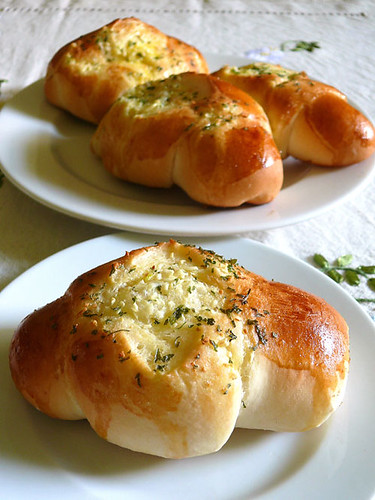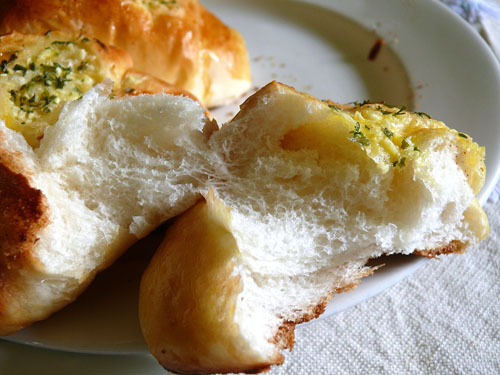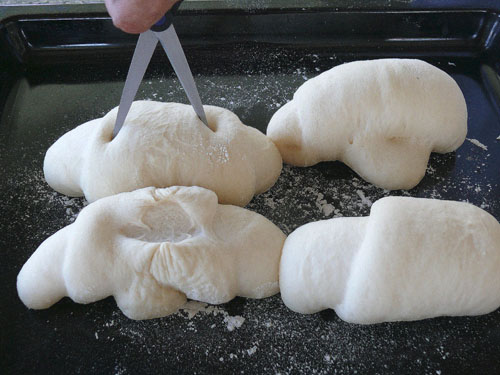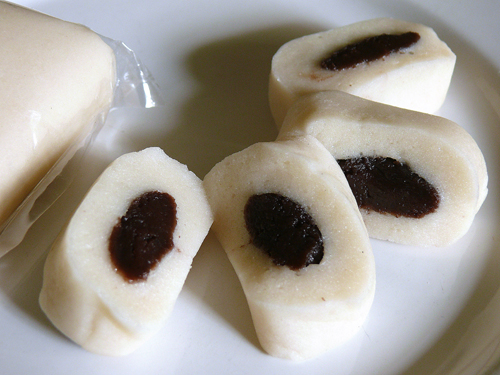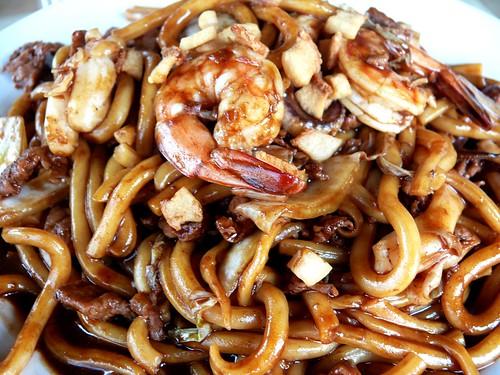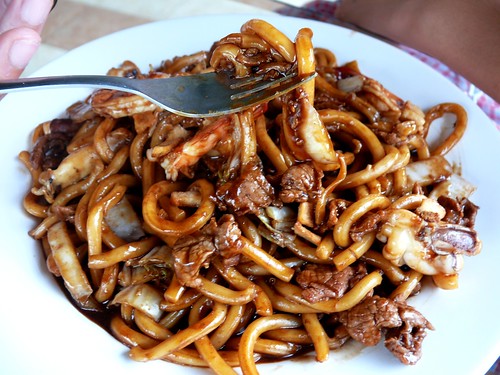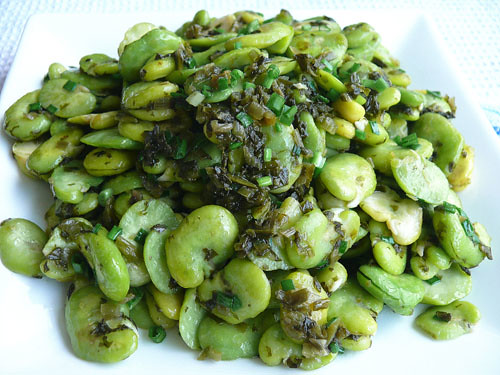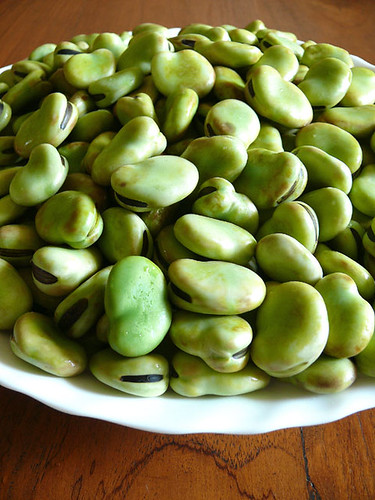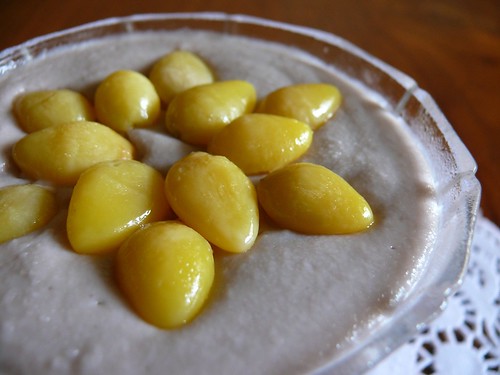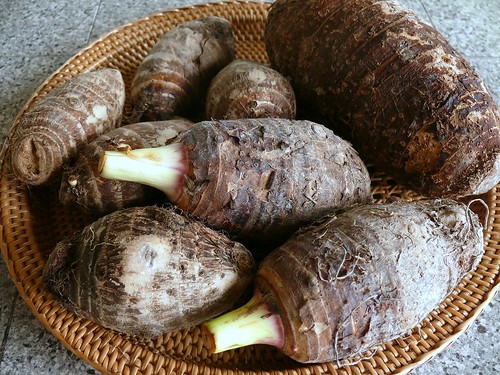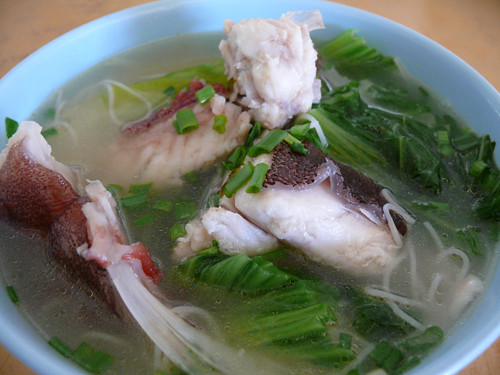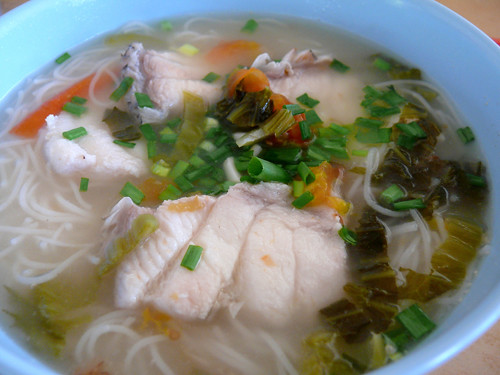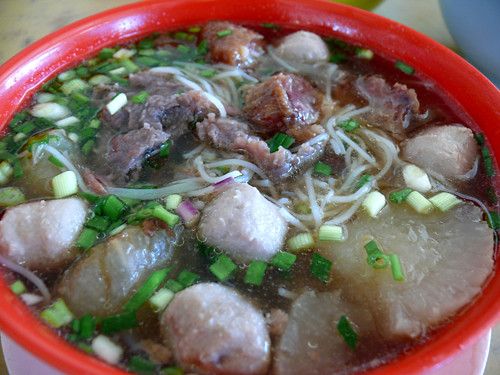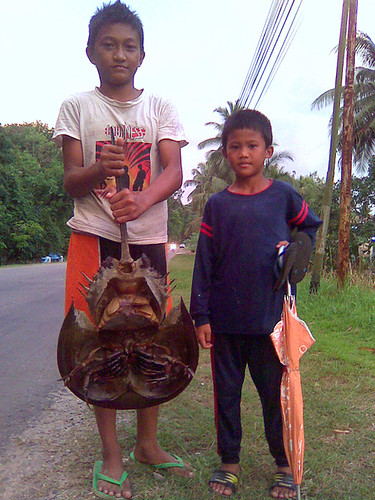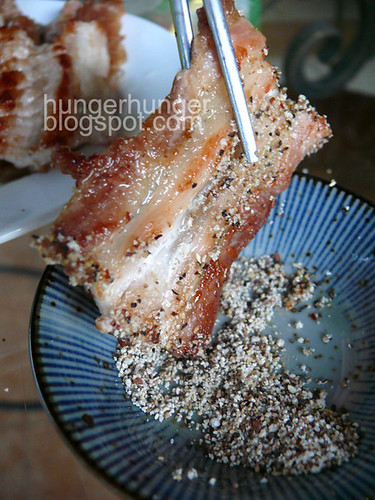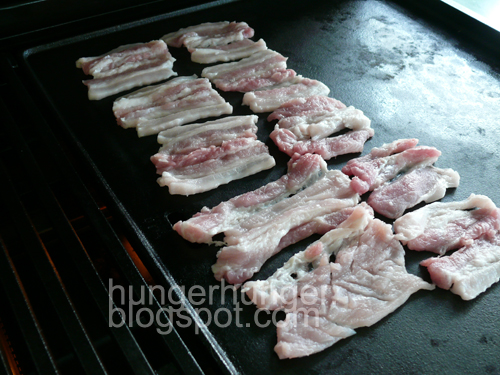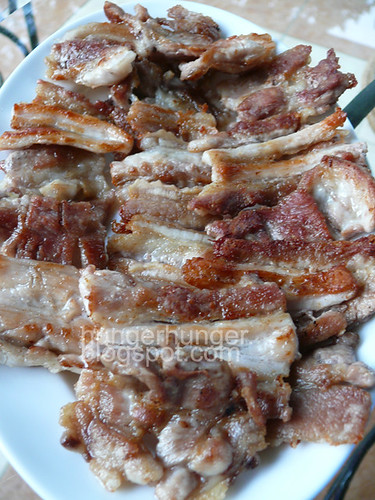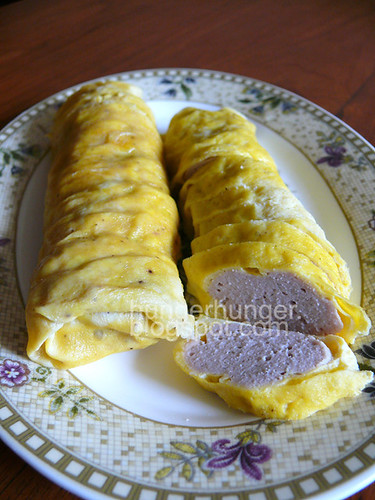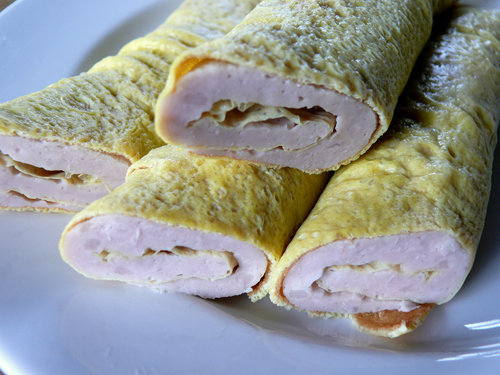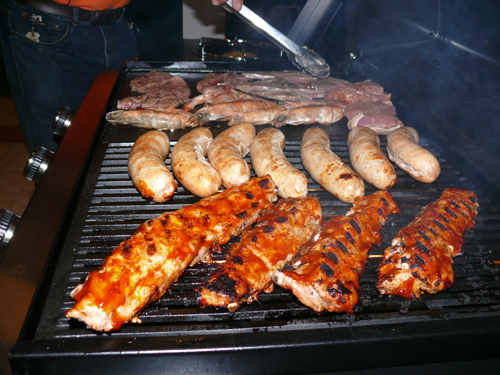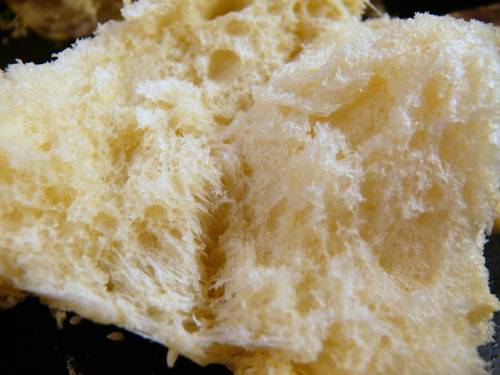Update: Today is again duan wu jie, the day we eat glutinous rice dumplings. I'm re-posting my 2007 post on glu rice dumplings because I didn't make any rice dumplings this year. I thought I'd wait until my kids are back from Melbourne next month for their winter break. It will be a feast everyday next month, and I'm getting ready by stocking up my fridge, fertilizing the daun kesom and mint (guess what for) and trying to loose 2 kgs (yes, those stubborn 2 kgs that have been dogging me since 2005) before bloating up again.
I have told you in my post below how the Chinese came to celebrate duan wu jie. Last week, the ex-president of Korea jumped to his death because he was plagued by legal moves against him for corruption while he was president in early to late-2000s. While it was shocking, and it is always tragic when someone takes his own life, I think he took the only honorable way out because jail would be too good for people who hold high public posts and abuse their positions. Roh may have been corrupt, but he had a conscience (or was it cowardice?) which is lacking in Taiwan's Chen Shui Bian. I can't believe Taiwan is so mesmerized by the actor-ex-president and moving so slowly to convict him, despite overwhelming evidence of massive corruption.
Post below was posted on 19/6/07:
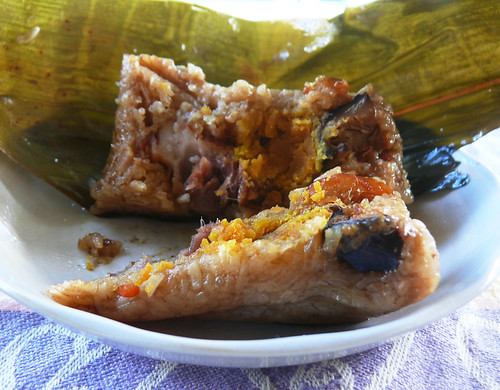
Today is
duan wu jie. Malaysians call
duan wu jie ( Fifth Day of Fifth Lunar Month Festival)
guo zhong jie which literally means "wrapping dumpling festival." According to my friend Lily from Jiangxi, China this festival started in 200 BC to commemorate Qu Yuan, an advisor and poet to the King of Chu State in China. A wise and much-loved statesman, Qu Yuan committed suicide by jumping into a river when he was saddened by the weak and corrupt court which had led to occupation of his state by another king. To prevent the fish in the river from getting to his body, the people made
zhongzi (glutinous rice dumplings) and threw them into the river. Wow. Thank goodness for such integrity and patriotism or we wouldn't have
zhongzi.
My kids grew up eating my MIL's Shanghainese
zhongzi and through the years I've tried to wean them by buying the local
zhongzi, which are mostly Cantonese
zhongzi, but they stubbornly declare Shanghainese
zhongzi are the best. I think both are great, the difference being Shanghainese
zhongzi are more flavorful because the rice is flavored with soy sauce (so they're light brown as versus white Cantonese
zhongs) and the pork is marinaded days ahead in soy sauce and
saoxin wine. However, where they win in taste/flavor, the Shanghainese
zhongzi lose in the variety of stuffing. True Shanghainese
zhongzi has a huge piece of marinaded fatty pork, and thats it. I say "Boring" in retaliation to my Shanghainese FIL's accusation of "Zha qi zha ba" which means hodge podge, in reference to the Cantonese
zhongzi of pork, chestnuts, green or black-eyed beans, salted egg yolk (yums!), dried shrimps, dried mushrooms and even sweetened peanuts (yuks). When I was little, my Dad tortured us with his 'pillow'
zhongzi. It's as big as a telephone and to warm it up, he's have to cut it into smaller pieces and fry it and it really was a terrible jumble!
Well, the kids miss their Grandma's
zhongzi this year because she won't be back from Shanghai till tomorrow so I bravely took on my MIL's role and made her
zhongzi today. I've helped her make
zhongzi once and tried it at home once and then swore I'd never make them again. So much work! But you know what, when Wey pronounced at first bite that its very close to Grandma's, I almost collapsed with happiness. Here I share my MIL's Shanghainese
zhongzi recipe but I have improved it by adding salted egg yolk, dried mushrooms and dried shrimps. I think its the best of both
zhongs.
Shanghainese Zhongzi
1) Glutinous rice

-wash well and drain. For every kilo of glutinous rice, mix in 1 T veg oil, 1T dark and 1 T light soy sauces, 2 1/4 t to 2 1/2 t salt and 1/3 t msg. Do taste the uncooked rice and adjust the taste to your liking, remembering that after boiling the zhongs will absorb water and expand and taste less salty than the uncooked rice. Season the rice about 1 hour before using it.
2)Fatty pork
- Use belly or the fatty part of pork shoulder. Remove skin. Cut into 3cm by 5 cm pieces, or larger if like. Marinade pork at least 3 days ahead with
saoxin wine (about 3 T for each kg of pork), dark soy sauce for color, white pepper and salt.
3)
Zhong leaves

-My cousin in Quilin had a
zhong plant and I was surprised because I always thought
zhong leaves are bamboo leaves. Lily said that
zhongzi wrapped with fresh
zhong leaves have a most wonderful smell, much better than the dried leaves. When my kids came home yesterday they were sniffing the air and drooling over the
zhongs that were being boiled. Must smuggle the plant in some day. It looks like a nice ornamental house plant.
-Just plunge the leaves in boiling water till softened. Cut off the first 3cm because the petiole will pierce and tear the
zhongzi if you don't remove it.
-Take out and soak in cold water, preferably overnight or the leaves will give a slight bitter taste to the zhongs.
4) Wrap
zhongzi according to the desired style. I find this the hardest part because I'm all foot! Shanghainese
zhongs are a twisted rectangle shape, unlike the pyramidal shape of Cantonese
zhongs. Try and get natural weedstrings or even cotton yarn like I did to tie the
zhongs. The commercial
zhongzi are all tied with plastic 'raffia' and its just worrying when you consider that the
zhongs have to be boiled for 3 hours. Make sure the water covers the
zhongs.
Update: MIL has tasted my
zhongxi and wasn't very impressed. Tips she gave me: don't tie
zhongs too tight or the rice will not be able to expand/cook evenly. The pork pieces should be bigger, in rectangular size so all section of the
zhongs will have some pork. The rice should be left to marinade an hour or so.
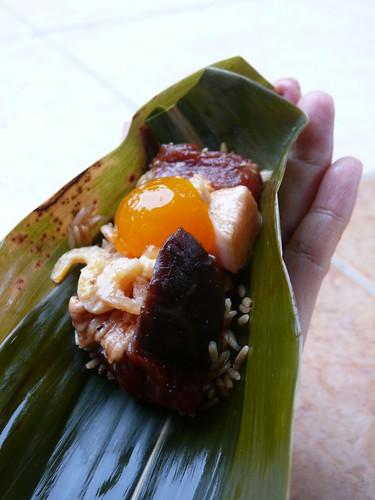 True Shanghainese rice dumplings will only have a large piece of marinaded pork, no dried shrimps, mushrooms etc. Mine's a cross between Cantonese-Shanghainese, like my kids.
True Shanghainese rice dumplings will only have a large piece of marinaded pork, no dried shrimps, mushrooms etc. Mine's a cross between Cantonese-Shanghainese, like my kids.
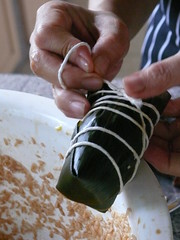
 (credits to Hongyi for taking these awesome pics!)
(credits to Hongyi for taking these awesome pics!)

